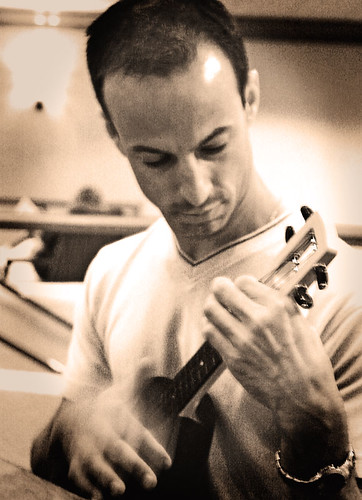A SPOONFUL OF AZUKRE HELPS THE MEDIKUNTZA GO DOWN.

We spent the past weekend in and around Vitoria in the Basque Country. Little did we know – although we certainly would’ve, had we done the slightest bit of research beforehand – that Vitoria’s “Fiesta en Honor de la Virgen Blanca” (Festival of the White Virgin) was in full swing.
The Festival was a boisterous affair full of drinking, dancing and music. Many Vitoria residents dressed the part. Men and boys wore brown leather slippers, white stockings, black knickers, white shirts, black vests, a black and gray checkered kerchief around the neck and a txapela (i.e., a big floppy beret that might be mistaken for a squid-ink pizza). Some carried a bota, although I can’t say whether this was done for reasons of tradition or convenience. Women and girls wore black and gray peasant outfits consisting of long skirts and frilly blouses, and wrapped their heads – Aunt Jemima-style – in a black kerchief. Babies of each sex were likewise adorned…right down to the bota.
Strolling bands of musicians seemed to be at every turn. They were mostly run-of-the-mill brass bands with the odd bagpiper thrown in for good measure, but there was at least one notable exception.
The “Plastic System Band” – a group of high-energy, French-speaking, black musicians dressed as red devils – flew in from the island of Martinique and set Vitoria ablaze with its pulsing rhythms and thrusting pelvises. Crowds parted and heads turned as they marched through the streets pounding on drums made from red spray-painted plastic barrels. Then again, I suppose that a group of French-speaking black men dressed as red devils would turn heads in the Basque Country even if they were quietly enjoying a game of whist in the park.
At high noon, we wedged ourselves into the Plaza de España to watch an umbrella-wielding mannequin of the mythical Basque figure “Celedón” fly across the diameter on a wire strung overhead. I don’t know who Celedón is or why he flies with an umbrella, but I would not be surprised if some patriots should cite him as proof that Mary Poppins is of Basque descent. I might lend more credence to such a claim if, for example, a flowered hat carbon-dated to the year 1416 had been unearthed at an archeological dig near the cod fishing banks of Nova Scotia. But to my knowledge, there’s been no such find.
I was not able to take a digi photo of Celedón’s high-wire act, because my wife thrust a camcorder into my hand and vowed dire consequences if I failed to record the entire event on video. But don’t despair. You can, thanks to the magic of Google, see a photo of Celedón at others' websites.
The Festival was a boisterous affair full of drinking, dancing and music. Many Vitoria residents dressed the part. Men and boys wore brown leather slippers, white stockings, black knickers, white shirts, black vests, a black and gray checkered kerchief around the neck and a txapela (i.e., a big floppy beret that might be mistaken for a squid-ink pizza). Some carried a bota, although I can’t say whether this was done for reasons of tradition or convenience. Women and girls wore black and gray peasant outfits consisting of long skirts and frilly blouses, and wrapped their heads – Aunt Jemima-style – in a black kerchief. Babies of each sex were likewise adorned…right down to the bota.
Strolling bands of musicians seemed to be at every turn. They were mostly run-of-the-mill brass bands with the odd bagpiper thrown in for good measure, but there was at least one notable exception.
The “Plastic System Band” – a group of high-energy, French-speaking, black musicians dressed as red devils – flew in from the island of Martinique and set Vitoria ablaze with its pulsing rhythms and thrusting pelvises. Crowds parted and heads turned as they marched through the streets pounding on drums made from red spray-painted plastic barrels. Then again, I suppose that a group of French-speaking black men dressed as red devils would turn heads in the Basque Country even if they were quietly enjoying a game of whist in the park.
At high noon, we wedged ourselves into the Plaza de España to watch an umbrella-wielding mannequin of the mythical Basque figure “Celedón” fly across the diameter on a wire strung overhead. I don’t know who Celedón is or why he flies with an umbrella, but I would not be surprised if some patriots should cite him as proof that Mary Poppins is of Basque descent. I might lend more credence to such a claim if, for example, a flowered hat carbon-dated to the year 1416 had been unearthed at an archeological dig near the cod fishing banks of Nova Scotia. But to my knowledge, there’s been no such find.
I was not able to take a digi photo of Celedón’s high-wire act, because my wife thrust a camcorder into my hand and vowed dire consequences if I failed to record the entire event on video. But don’t despair. You can, thanks to the magic of Google, see a photo of Celedón at others' websites.
Incidentally, we had lunch at a stellar (and inexpensive) little eatery called Xixilu (chee-CHEE-loo) located at Plaza Amárica, 2 in Vitoria (Tel: 945-23-00-68). The ventresca (tuna belly) with tomatoes, menestra de verduras (sauteed vegetables) and green asparagus with Cabrales cheese were outstanding. And the beer was VERY cold. All four of them.


3 Comments:
BTW, was that my mother-in-law flirting with one of The Plastic System Band musicians? After all, they say that French is the language of love...no?
We were talking about Virgins, something very appropriate being himself a Devil....On the other hand you, men, were delighted with the She/devils and their thrusting pelvises.
Your mother in law
Yeah, I guess we were.
Post a Comment
<< Home